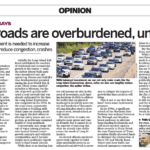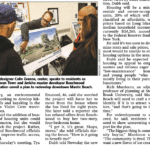The following was written exclusively for The Foggiest Idea, and published on June 4, 2018. Interested in supporting The Foggiest Idea’s award-winning reporting and analysis? Click here.
By Richard Murdocco
As the springtime flowers started to bloom outside the Crest Hollow Country Club in 2015, Syosset Park Development LLC, a cooperative effort by Castagna Realty, the Albanese Organization and the Indianapolis-based Simon Property Group unveiled their grand ambitions for the former Cerro Wire property in Syosset to a modestly sized, sleepy crowd.
Coming off a perceived victory after a lengthy public battle over the luxury mall proposed by Simon’s arch rival, Michigan-based Taubman Centers, the mood of the community at the catering venue was cautiously optimistic. At the time, Syosset Park drew little attention aside from those in attendance. The development team proposed 625 town houses and condominiums, two hotels, a 30-acre park, stores, offices and restaurants on the parcel, a former town landfill (a cleaned-up federal Super Fund site) as well as a town public works complex.
While media outlets covered the proposal (including The Foggiest Idea, which first broke the details of the project that evening and explored the proposal further for The Long Island Press and The Real Deal in both reported and op-ed work) there was little public reaction. From the limited feedback at the time, local people seemed content with the fact that Syosset Park simply wasn’t going to be a mega-mall.
That was then.
A few years later, with the project’s environmental review process well underway, the development has attracted intense scrutiny from area residents and the Syosset Central School District. The backlash first stewed on social media but has since bubbled over into the real world, where opposition to Syosset Park has turned into a firestorm.
Despite the fervor, the project does have its merits. The TFI first approached the project with cautious optimism since Syosset Park is a much better option for the community than Taubman’s original proposal.
But substantive questions still remain – and residents deserve answers to their legitimate concerns over the environmental soundness of the property, as well as how this proposal will fit in with other large regional projects on Long Island.
At a recent marathon six-hour public hearing on Syosset Park’s draft environmental impact statement (DEIS) held at Syosset High School in May 2018, the mood was notably darker than it was at the Crest Hollow Country Club. This time about 700 people were in attendance. Speaker after speaker took issue with different aspects of the project, focusing particularly on the need for independent environmental testing at the long-troubled and dirty site where Cerro Wire Factory once made steel electrical conduits, copper rods and steep strips for the construction industry until 1986 when it ceased.
One resident of 35 years who lost both his sister and neighbors to cancer said there were 316 similar cases in the immediate area. “I don’t want anyone else to die,” he told the audience. “I know too many people who died.” Others discussed the impact the project would have on Syosset’s schools. “How do we expect second and third graders to be productive in a classroom when a city is being built fifty yards away?” a resident asked.
Even before the public hearing, rumors had begun circulating on Facebook that paid actors posing as residents would attend, no doubt setting the tone for the evening. When Kevin Law, CEO of the developer-friendly Long Island Association, spoke in support of the project, the crowd erupted in a chorus of boos. One audience member yelled that Law was a carpet-bagger since he didn’t live in the immediate area. Throughout the proceedings, the Town of Oyster Bay’s embattled town board sat stone-faced.
In recent weeks as well as at the hearing, the Syosset Central School District openly expressed concern about the project’s scale. In a letter signed from the district’s superintendent, Dr. Tom Rogers, the school board told residents that “we believe we have an obligation to thoroughly outline the implications of this proposed development to the school district.” The letter expressed the board’s commitment to follow “a methodical process” as they assess the proposal.
The project’s impacts on the school district, one of the top performing ones on Long Island and in the past a magnet for criticism over their previous superintendents’ pay, is likely to be substantive. The school district estimated that the project will bring enough children to necessitate building two new classroom wings, an endeavor slated to cost $17 million, as well as create the need for $12 million in additional annual costs once the project reaches full-build out.
To help the district wrap its head around the proposal, Superintendent Rogers hired the Hauppauge-based engineering firm H2M to review traffic and construction impacts. As it turns out, H2M was also hired by the Town of Oyster Bay to conduct independent testing of the project site. In a stern letter to local residents, the district said it was “disturbed” to learn about H2M’s doing work for the Town, calling it “deeply unfortunate” and saying that the firm’s dual role “poses an indefensible conflict of interest for H2M, as it prevents us from communicating to our residents that the analysis we are conducting is unbiased when the same firm is also working for the Town.”
To Patrick Halpin, a former Suffolk County Executive who now works as a consultant for Syosset Park’s development team, the proposal is a big step forward for the community.
“It’s a very good project,” Halpin told The Foggiest Idea. “It sets a high bar for smart growth on Long Island.” When asked about the impacts on Syosset area schools, Halpin noted how enrollment had dipped in recent years when compared to a decade ago. Regardless of the demographic shifts, he expressed confidence that a resolution to the district’s concerns could be found either via policy changes or with fiscal measures, or with a mix of both. “While no final decision has been made, perhaps a certain percentage of the residential units can be 55 or older,” Halpin said. “It won’t become an expense.”
Responding to community concerns voiced at the recent hearing, Charles Davis, Jr. of Simon Property, Group Senior Vice President of Development, issued a statement promising to call for independent testing at the Syosset Park site.
“Syosset Park has worked for five years to develop a plan that evolved from the community and that the community can embrace, one that is not only environmentally safe and sound but that enhances the value of our neighbors’ homes while helping the school district and town with new sources of much-needed revenue,” Davis wrote. “Like our neighbors, we want to be certain the groundwater and soil on this site, as well as the gas emitted from the town’s landfill, is safe as we meet our unwavering commitment to protect human health and the environment throughout this process.”
Although it wasn’t the focal point of the public hearing, the large project’s links to transit raise questions as well.
Buried within Syosset Park’s sizable Draft Environmental Impact Statement, the developer essentially dismissed the prospect of reopening a former Long Island Rail Road train station that had been near the Cerro site on the south side of Robbins Lane, which is now proposed to be a major access point for the project. According to the document, the developer argued that since the site is owned by a private entity that wishes to develop it, “there is no potential for re-establishing the Landia Station at the subject property.” The LIRR closed the station in October 1973. Former Nassau County Legislator Judy Jacobs pressed for its reopening in 2006 but to no avail.
Asked why the option is off the table, Halpin cited past proposals as part of the reason. “The Nassau County Planning Commission rejected the creation of a stop there in the Eighties but I don’t know why they did,” Halpin said matter-of-factly. “Today, a station would create enormous amounts of traffic,” he noted, mentioning that a new stop would need space set aside for large parking areas. Asked how the project could still be considered smart growth without dedicated transit access, Halpin came to the point. “It’s not transit-oriented,” he replied, “but since we’re providing shuttle buses to area stations, it’s still smart growth.”
A seasoned policymaker himself, Halpin was brought on board by the Cerro Wire Coalition five years ago, when the fight against the Taubman mall was in full-swing. “I told them at first: you’re all just a bunch of NIMBYs,” Halpin recalled. “They couldn’t just be against the mall. They had to be for something.”
That something was Syosset Park. Halpin said that in the years since the project was first proposed, the demographics of the community changed, suggesting that population shifts may have impacted awareness of the proposal. “There has been a large influx of Chinese and new families in the area who are unfamiliar with what happened five years ago,” Halpin said, referring to the embattled history of the property, including the site’s Super Fund clean-up, the long mall fight, and the subsequent land sale.
“Syosset Park has an obligation to get out there,” Halpin said. “We’re confident we can address their concerns,” he added. “Whether it changes their minds, well, that remains to be seen.”
Richard Murdocco is an award-winning columnist and adjunct professor in Stony Brook University’s public policy graduate program. He regularly writes and speaks about Long Island’s real estate development issues. More of his views can be found on thefoggiestidea.org or follow him on Twitter @thefoggiestidea. You can email Murdocco at Rich@TheFoggiestIdea.org.















Great piece. The Syosset Park proposal has a lot of merits but also concerns that need to be addressed. What we DONT need (and I say WE in a regional sense since Long Island in reality blends from one hamlet to the other with no definite boundaries at times) is a massive unproductive weed strewn lot for decades to come. I hope something meaningful and relatively significant is eventually developed there.